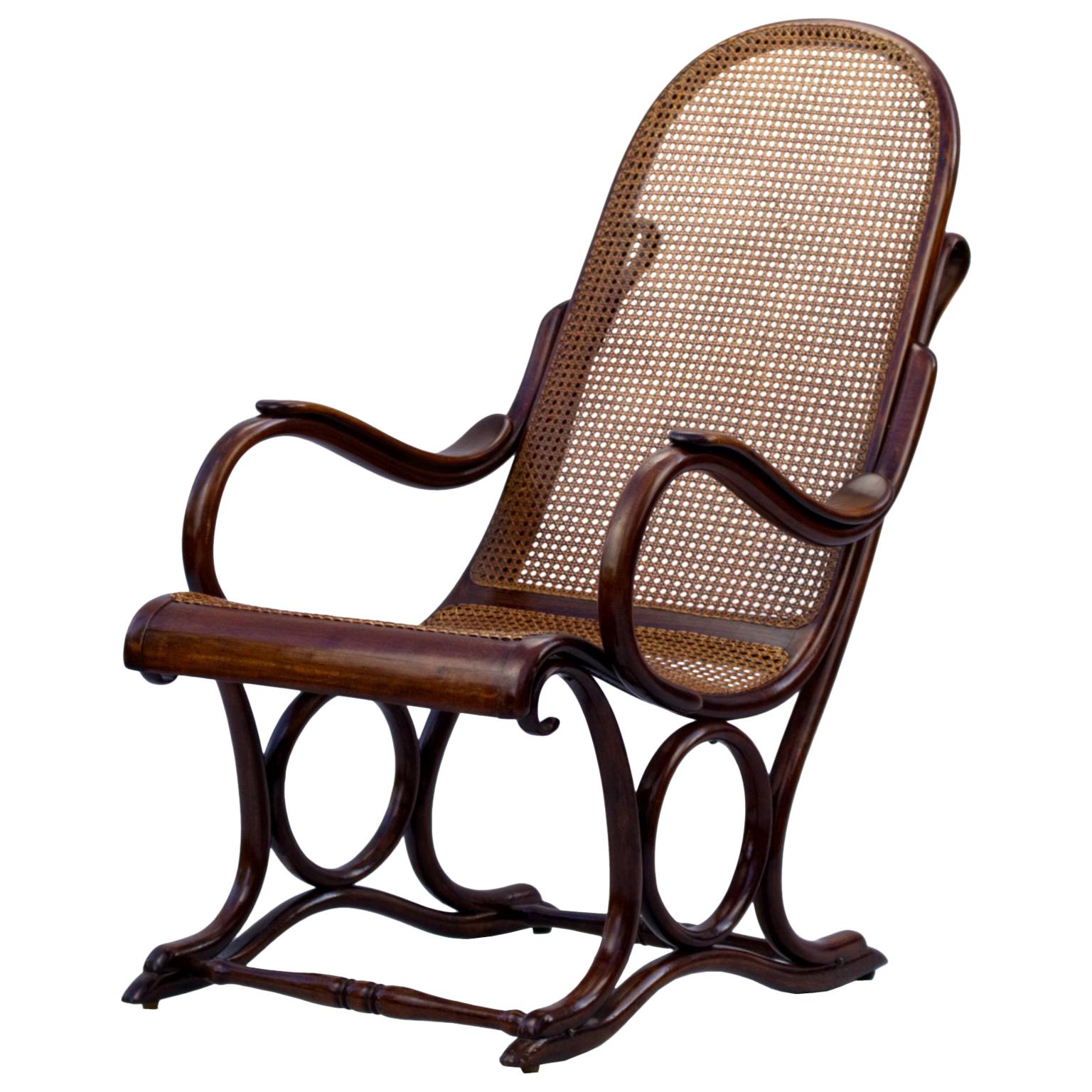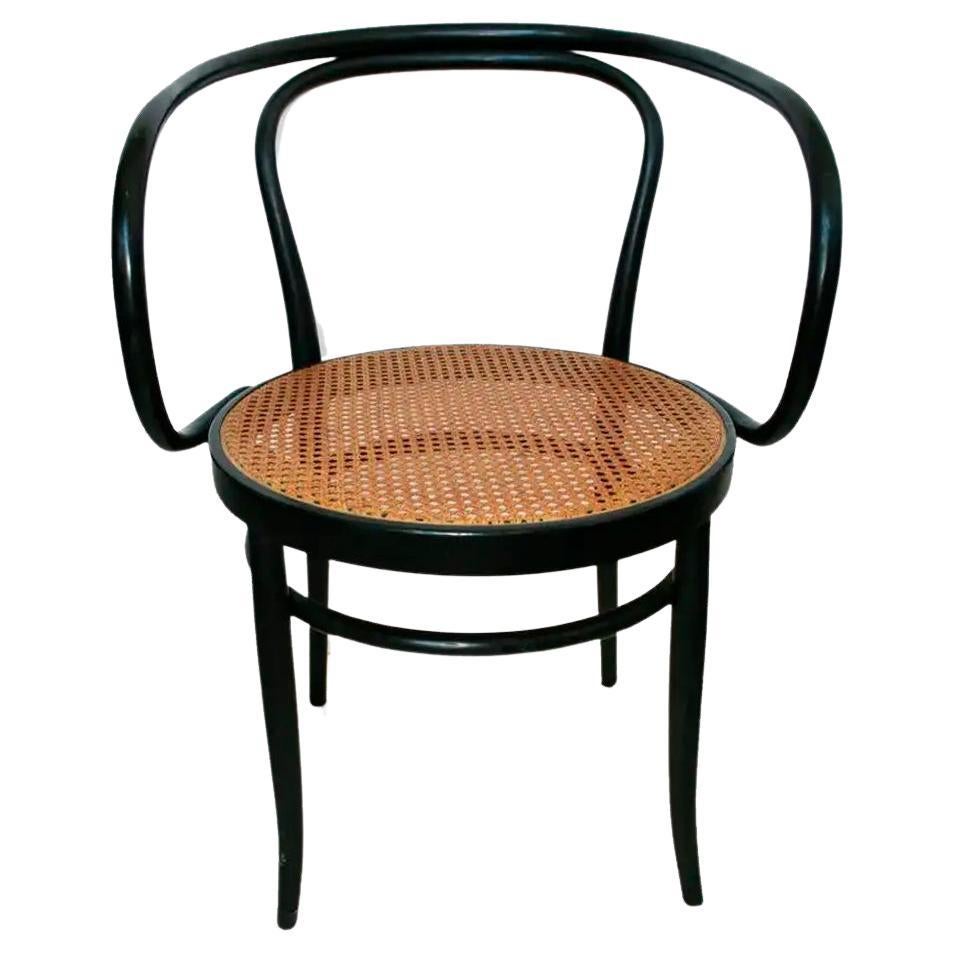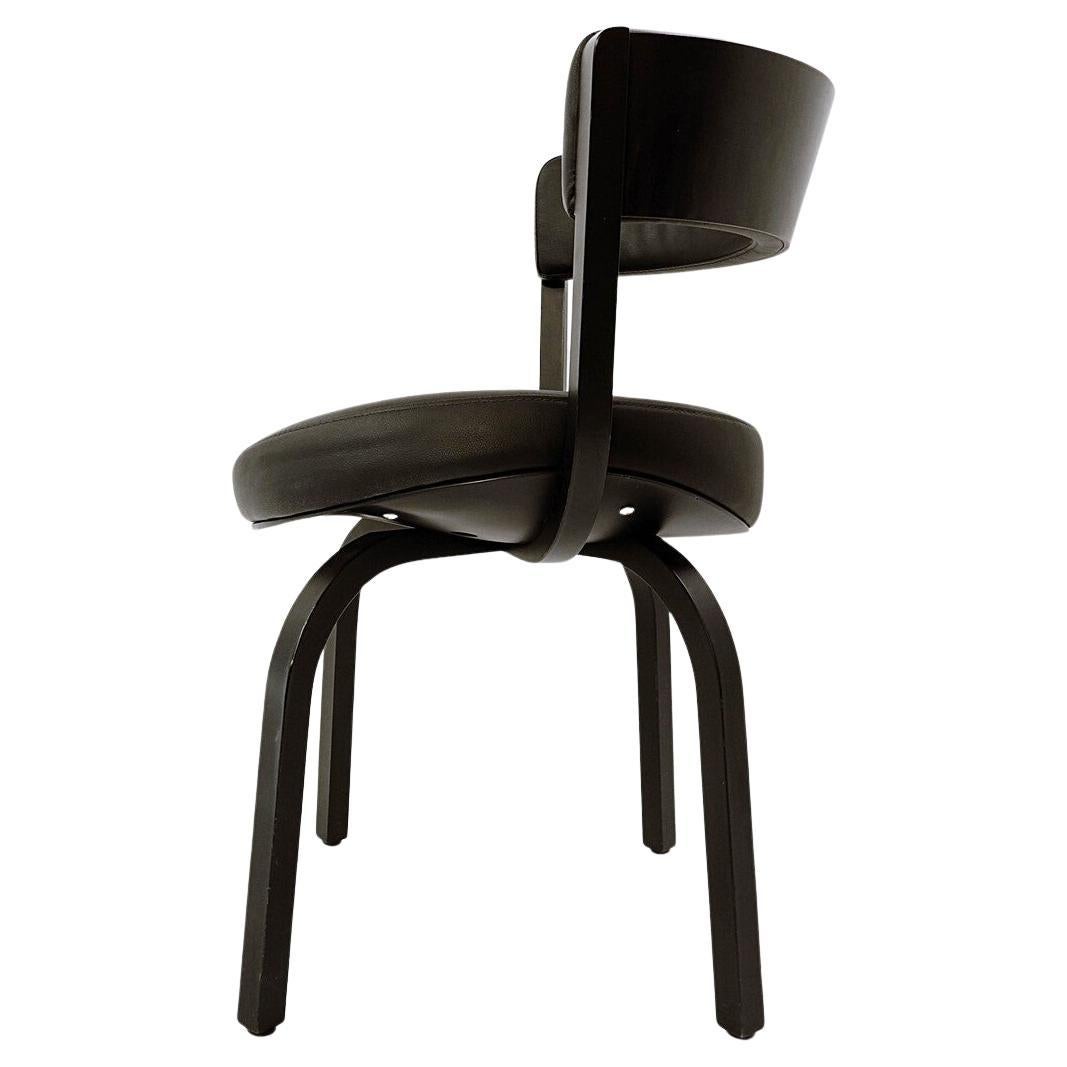Items Similar to Illustrated Thonet Chair
Want more images or videos?
Request additional images or videos from the seller
1 of 11
Illustrated Thonet Chair
About the Item
Thonet armchair with a printed illustration.
The seat and backrest are weaved in rattan. The rest of the frame is covered in a print
that could have influenced by the great Fornasetti. The chair is marked on the inside of the seat.
Europe, 1930s.
- Creator:Thonet (Manufacturer)
- Dimensions:Height: 31.11 in (79 cm)Width: 26.78 in (68 cm)Depth: 25.99 in (66 cm)
- Style:Art Nouveau (In the Style Of)
- Materials and Techniques:
- Place of Origin:
- Period:
- Date of Manufacture:1905
- Condition:Wear consistent with age and use.
- Seller Location:Antwerp, BE
- Reference Number:1stDibs: LU933417031002
About the Seller
4.8
Gold Seller
These expertly vetted sellers are highly rated and consistently exceed customer expectations.
Established in 2008
1stDibs seller since 2012
981 sales on 1stDibs
Typical response time: 10 hours
- ShippingRetrieving quote...Ships From: Antwerpen, Belgium
- Return PolicyA return for this item may be initiated within 14 days of delivery.
More From This SellerView All
- Cesca Chair by Marcel Breuer for Thonet, Germany, 1990sBy Marcel Breuer, ThonetLocated in Antwerp, BECesca armchair model S64 by Marcel Breuer for Thonet, crafted in 1992. The frame, meticulously constructed from tubular chrome steel, exudes modern elegance, while the distinctive ra...Category
1990s German Mid-Century Modern Armchairs
MaterialsMetal
- Thonet style Hand Carved Wooden Dining Chairs, Mid-Century Modern, 1960sBy ThonetLocated in Antwerp, BEThonet; Austrian design; Furniture design; Armchairs: Hand-crafted; Mid-Century Modern; Sedie Bianche Lengno Scolato; Dining chairs; Craftsmanship; 1960's; Thonet style hand-carved wooden dining...Category
Vintage 1960s Austrian Mid-Century Modern Dining Room Chairs
MaterialsFabric, Wood
- Functional Art Chair / Throne "'Spring Swab" by Lionel JadotBy Lionel JadotLocated in Antwerp, BECollectible design / Functional art, Lionel Jadot for Everyday Gallery, Belgium 2020 Born in Brussels in 1969, Lionel Jadot is an interior designer, artist, designer, filmmaker, adventurer. But all at once, preferably. Lionel Jadot is firing on all cylinders. ‘I never throw anything, I pick up everything. Not having a green thumb, I’m trying cuttings, weddings against nature. I never forget a line.’ He’s inviting us in subtle, off-beat worlds, on the edge of reality. Its material is made of dilated time. A wandering spirit, he seeks a protective balance in a hostile world. It is his constant questioning: what happens to the place where we live? For Lionel Jadot, everything is object, everything is history. He draws from other places, other times, and seeks what’s linking them. He sews, stitches, unpicks, blends materials, combines eras. He will enshrine some wood essence in metal, some mineral in a plant, the old in the new. ‘I take extra care to the joint between two materials.’ With him, there is always some play in the parts, as in a piece of machinery. From a kingdom to another, he provokes organic, viral growths, generating energy. Linking past and future, he never forgets a line. ‘I accumulate them.’ He’s inviting us in subtle worlds, off-beat, on the edge of reality. Are we in 1930 or in 2030? Both, no doubt. Its material is made of dilated time. The eye goes hand in hand with the ear. ‘When I walk into a place, I listen to the good (or bad) it does to me. An ineffable feeling.’ He recreates mutant buildings, like the future Royal Botanique, a 5 stars hotel housed in the Church of the Gesu, a former convent behind a 1940 façade. He talks about a ‘hotel object’, which he holds and turns around in his hand. A wandering spirit, he’s flirting with retro-futurism. The Jam, another hotel, is intended for urban travelers, fans of swiftness, fluidity and hospitality. He designs interiors as a set of objects: a motorcycle cut in concrete becomes a bar counter. He finds gothic cartoon echoes, from the likes of Moebius, Alejandro Jodorowsky, Enki Bilal, sets from Garage Hermétique and Blade Runner, a protective balance in a hostile world. Discovering Jadot’s little cosmos of collected and accumulated goods, it becomes clear that every element has its own story. I tried to collect them and in turn, devour them in the coming paragraphs. But first: the show is best experienced seated, barring the distinction between object of use and object of attention, they invite for different types of conversation. The seats, chairs, thrones all make us think of our own physical comportment, and of how the seat lends grandeur to the person sitting on it, by crowning its presence. The crackling floor, the felt walls and the diffuse light slow you down into an oddly absorbing environment, in which you are left puzzled. In the eclectic collages of objects, bits and pieces collected all over the world come together in ways practical, and logical, though possibly only in the artist’s mind. All his finds eventually seem to fall into place. Starting with the mere conception of a chair, rather than with a set-out plan or sketch, the works are intuitively construed out of an archive that one can only imagine the dimensions of. Things forgotten by others, precious for him, were all once designed for their own purpose. Here they find their fit as a base, a closing system or a balancing element. The first piece that opens the exhibition, the most throne-like of all seats in the show, builds around a chair of his grandmother, protected by mops, and harassed with bed springs. As you enter the space, you pass by a shell leaning over a yellow seat that stems from his old Mustang, and find a white stool piece with Mexican leather dog training whips— the white building blocks of which turn out to be dried molding material, as found and broken out of a bucket by workers every morning. Further, the stone piece that reminds one of the stone age, is indeed made of 400 million old rocks, and the soft seats are lent from construction, where these strokes of textile carry up the heaviest goods. In the corner — but as you walk this walk please be seated on any of the thrones and experience the work for a moment— the green fluffy cover is made by XXXX who remakes cartographies of warzones, one of which is here mounted on a flexible fishing chair. On an experience level, the conversation chair enhances self-confidence, while putting you literally in a good spot with the person you’re conversing with. The lamp perfectly shows the playful Cadavre Exquis...Category
2010s Belgian International Style Armchairs
MaterialsMetal
- Gerard Van Den Berg Arm Chair Modern, 1990sBy Gerard Van Den BergLocated in Antwerp, BEGerard Van Den Berg; arm chair; Modern; Plain, usually slightly curved, and yet suggestive and unmistakable forms are typical of Gerard van den Berg. The Dutch designer consciously goes for simplicity and for this very reason shows his creative ability. Van den Berg, born in 1947, studied furniture building and design at a technical college. In the Seventies, he founded together with his brother the Montis upholstered furniture company. Thanks to his designs the young company soon attained international recognition. It´s success did not stop van den Berg´s leaving Montis in the early Nineties. Since then he has been a freelance designer. His work for leading international furniture companies...Category
1990s Dutch Mid-Century Modern Armchairs
MaterialsWood
- Post-Modern Black & White Lounge Chair, Italy, 1970sLocated in Antwerp, BEItalian postmodern black and white lounge chair, a beautiful piece of furniture that seamlessly combines the timeless elegance of the 1970s design e...Category
Vintage 1970s Italian Post-Modern Chairs
MaterialsWood, Fabric, Bouclé
- 'T-Shink' Sprayed Textile Throne Chair, Lionel Jadot, Belgium, 2020By Lionel JadotLocated in Antwerp, BEThe 'T-Shink' functional art throne chair is constructed of elements from wooden moulds which date back to the 1950s and originally used to make stainless steel sinks...Category
2010s Belgian Post-Modern Chairs
MaterialsOther
You May Also Like
- Bentwood Cane Salonfauteuil Easy Chair Thonet No. 1, circa 1890By Thonet, Gebrüder Thonet Vienna GmbHLocated in Lucenec, SKVery rare antique Thonet easy chair no 1 produced by Gebruder Thonet from the late 19th century in a very good condition with new cane on seat, cane ...Category
Antique Late 19th Century Austrian Art Nouveau Armchairs
MaterialsCane, Bentwood
- Thonet Cane and Black Ebonized Bentwood Chair After Thonet 209By ThonetLocated in Mombuey, ZamoraThe chair after Thonet is from the years between 1950s This is Le Corbusier's favourite chair and one of the favourite designs of architects and designers. Unfortunately it has no...Category
Mid-20th Century Spanish Mid-Century Modern Chairs
MaterialsCane, Bentwood
- Art Nouveau Bentwood Salonfauteuil Easy Chair / Armchair Thonet No. 1 circa 1890By Thonet, Gebrüder Thonet Vienna GmbHLocated in Lucenec, SKVery rare antique Thonet easy chair no 1 produced by Gebruder Thonet from the late 19th century in a very good condition. New upholstery. Last picture is from Gebruder Thonet catalogue...Category
Antique Late 19th Century Austrian Art Nouveau Armchairs
MaterialsBentwood, Upholstery
- Thonet Chair 404 in Black Wood and LeatherBy ThonetLocated in Brussels , BEThonet chair 404 in black wood and leather.Category
Mid-20th Century Mid-Century Modern Armchairs
MaterialsMetal
- Set of Chairs by Gerd Lange for ThonetBy Gerd Lange, ThonetLocated in Čelinac, BASet of four chairs by Gerd Lange for Thonet.Category
Vintage 1970s German Mid-Century Modern Chairs
MaterialsMetal
- Pair of Vintage Bentwood Thonet Style Chairs in VioletBy ThonetLocated in Redding, CTPair of vintage bentwood Thonet style chairs in Violet. Price is for 2 chairs. Classic timeless design. This amazing color is very rare. The pair i...Category
Mid-20th Century Romanian Bauhaus Armchairs
MaterialsUpholstery, Bentwood
Recently Viewed
View AllMore Ways To Browse
Thonet Used
Thonet Chair
Thonet Chairs
Used Thonet Chairs
Thonet 20th
Antique Thonet Furniture
Thonet Antique
Thonet Antique Furniture
Armchair By Thonet
Antique Thonet Chair
Thonet Antique Chairs
Thonet Antique Chair
Thonet Chair Antique
Antique Thonet Chairs
Thonet Brown Armchair
Early Thonet Chairs
Thonet Art Nouveau
1930s Thonet





